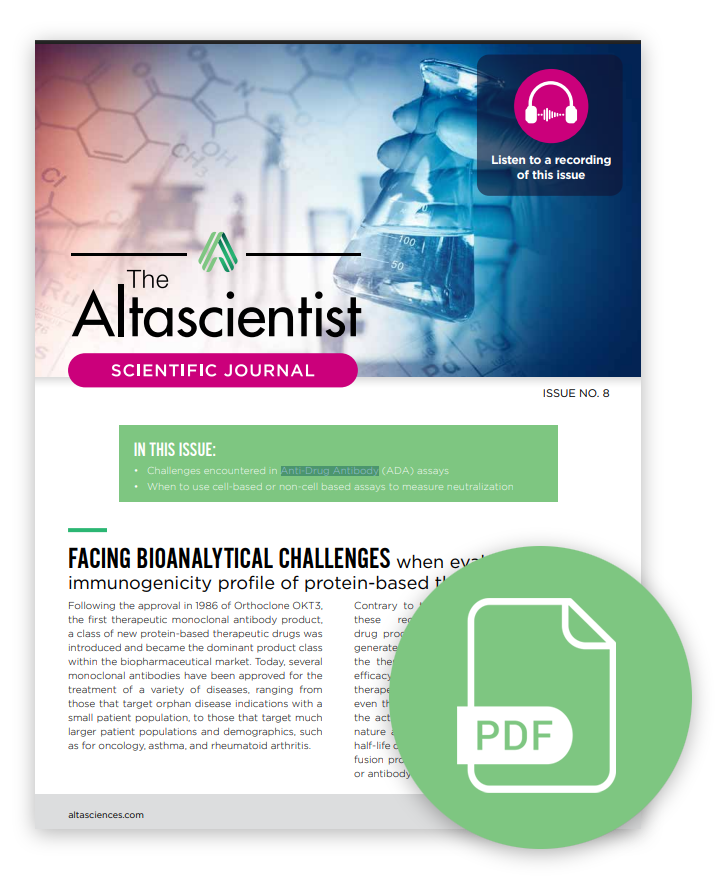ISSUE NO. 8 — Bioanalytical Challenges Encountered when Developing ADA Assays
Following the approval in 1986 of Orthoclone OKT3, the first therapeutic monoclonal antibody product, a class of new protein-based therapeutic drugs was introduced and became the dominant product class within the biopharmaceutical market.
antibody product, a class of new protein-based therapeutic drugs was introduced and became the dominant product class within the biopharmaceutical market.
Today, several monoclonal antibodies have been approved for the treatment of a variety of diseases, ranging from those that target orphan disease indications with a small patient population, to those that target much larger patient populations and demographics, such as for oncology, asthma, and rheumatoid arthritis.
In Issue 8 of The Altascientist, we explore the role of anti-drug antibodies (ADAs) in therapeutic development, their impact on efficacy, and detection strategies, including:
- Challenges encountered in ADA assays
- Cell-based or non-cell-based assays to measure neutralization
- How Altasciences can help
The Challenges of Anti-Drug Antibody Challenges Assays in Bioanalysis
Matrix interference in immunogenicity assays, especially when handling disease-type populations, is one of the most challenging parameters to resolve. Multiple factors can contribute to interference, such as the disease population and demographic, the drug itself, the rheumatoid factor (RF), the presence of a soluble target or receptor, an endogenous counterpart, a co-administered drug, pre-existing antibodies, and other proteins such as lipid or hemoglobin.
Another challenge is the limited access to oncology donors who appropriately represent the target population, often complicating the determination of the pre-study cut-point in immunogenicity oncology studies. The cut-point analysis must be assessed using the targeted population of the clinical study with a sufficient number of sample donors that are essential to yield a suitable statistical analysis for cut-point determination.
Ideally, the use of the specific disease population is preferable if a sufficient amount of donors adequately representing the clinical study are available. However, this is often not possible, and the challenge is even greater when the clinical study targets different disease types.
How Altasciences’ Expertise Can Overcome Bioanalytical Anti-Drug Antibody Challenges
As more therapeutic proteins are being developed, Altasciences’ technology and bioanalytical methods are evolving to achieve highly sensitive and robust ADA assays. This allows our team to detect positive ADA samples and characterize the immunogenicity risks associated with each therapeutic drug to ensure a better patient safety profile. Several strategies have been used at Altasciences to mitigate matrix interferences observed in disease populations, making it easier to assess immunogenicity in complex clinical studies aimed at targeting various populations.
Although some specialists may prefer to be more conservative and develop bioanalytical methods that are highly sensitive, at Altasciences, we stress the importance of putting into context the clinical relevance of the study to ensure that results generated in the ADA assay are not overestimated and misleading.
Explore all issues of The Altascientist in our Resource Center. And don’t forget to subscribe to “The Altascientist: Audiobooks” on Spotify, Apple Podcasts, or wherever you get your audio content.
Download publication